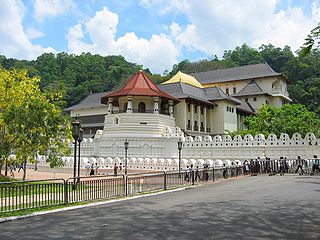
The Kandy Esala Perahera also known as The Festival of the Tooth is a grand festival celebrated with elegant costumes and is held in July and August in Kandy, Sri Lanka. This historical procession is held annually to pay homage to the Sacred Tooth Relic of Lord Buddha, which is housed at the Sri Dalada Maligawa in Kandy. A unique symbol of Sri Lanka, the procession consists of many traditional local dances such as fire-dances, whip-dances, Kandyan dances and various other cultural dances, in addition to the elephants who are usually adorned with lavish garments. The festival ends with the traditional diya-kepeema ritual, a water cutting ceremony which is held at the Mahaweli River at Getambe, Kandy.
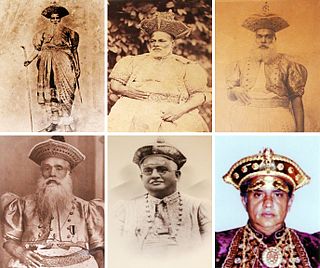
Diyawadana Nilame is the office of the chief lay custodian of Temple of the Tooth, Kandy, Sri Lanka. Formerly an office of the royal household, at present its the trustee for the Temple of the Tooth as defined by the Buddhist Temporalities Ordinance of 1931. A ceremonial position, enriched with over two thousand years of history to safeguard and carry out ancient rituals for the relic of the tooth of the Buddha. The Diyawadana Nilame has the responsibility of overseeing of all aspects of the Sri Dalada Maligawa. He has the traditional duty of organizing the annual pageant, the Kandy Esala Perahera. The current Diyawadana Nilame is Pradeep Nilanga Dela.
The Nàtha Devàla is located on the terrace, in front of the Palace complex of Kandy. It is said to have been in existence even before the Tooth Relic was brought to Kandy.The oldest extant structure in Kandy, it is said to have been built by King Vikramabahu III in the 14th century. The history of the worship of God Natha is not clear. The name 'Natha' literally means ‘no form’ and ‘no shape’, and is therefore generally associated with Lord Maitreya, the next Buddha.
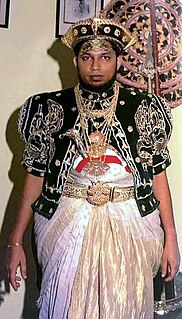
Neranjan Priyadarshana Dullewe Wijeyeratne is a Sri Lankan. He was Diyawadana Nilame of the Sri Dalada Maligawa, Kandy for 20 years from 1985 to 2005. Wijeyeratne was former United National Party politician and ex chief organiser for the Galagedara Electorate in Kandy District and former Leader of the Opposition in the Kandy Municipal Council.
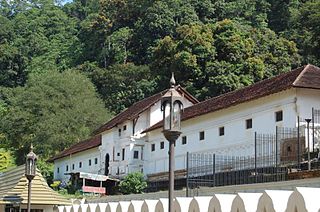
The Royal Palace of Kandy, located to the north of the Temple of the Tooth in Kandy, was the royal residence of the Sri Lankan monarchy of the Kingdom of Kandy in Sri Lanka. The last king to reside in it was King Sri Vikrama Rajasinha (1798-1815). Once part of a large palace complex that included the King's Palace, Royal Audience Hall, Queen's Palace, King's Harem Quarters and Queen's Bathing Pavilion (Ulpange), together with the Temple of the Tooth. Adjacent to the Royal Palace is the Victorian era building that until recently housed Kandy High Court.

The Kingdom of Dambadeniya was a medieval kingdom in what is present day Sri Lanka. The kingdom's rulers reigned from 1220–1345.

The National Museum of Kandy in Kandy, Sri Lanka is located next to the Temple of the Tooth in part of the former Royal Palace of Kandy. The primary exhibits are housed in the Palle Vahala building, which was the former home of the King's harem. A secondary exhibition is located in the main palace building. The museum is maintained by the Department of National Museums.

Raja was a Sri Lankan tusker elephant belonged to the Sri Dalada Maligawa, Kandy. Raja participated at the annual Esala procession in Kandy for around 50 years and was the sacred casket bearer of the final Randoli perehera for 37 years. He was one of the most celebrated elephants in Asia during his lifetime, and was world famous for his noble behavior. On August 20, 1986 former Sri Lankan President J. R. Jayewardene declared Raja as a national treasure, in recognition of his valuable services to the religion and culture of Sri Lanka.

1989 Temple of the Tooth attack is an attack on the Temple of the Tooth Relic, located in Kandy, Sri Lanka. The shrine, which is considered to be important to the Buddhists in Sri Lanka, houses the relic of the tooth of the Buddha, and is a UNESCO designated World Heritage Site. It was attacked on 8 February 1989, allegedly by the armed cadres affiliated to Janatha Vimukthi Peramuna (JVP), a Marxist-Leninist Communist political party in Sri Lanka.

1998 Temple of the Tooth attack is an attack on the Temple of the Tooth Relic, located in Kandy, Sri Lanka. The shrine, which is considered to be important to the Buddhists in Sri Lanka, houses the relic of the tooth of the Buddha, and is also a UNESCO designated World Heritage Site. In 1998, it was attacked by Liberation Tigers of Tamil Eelam (LTTE), a separatist militant organization which fought to create an independent Tamil state in Northern and Eastern parts of the country, from 1983 to 2009.

Heiyantuduwa Raja was a Sri Lankan elephant, which carried the Relic of the tooth of the Buddha casket in the Dalada Perahera for 11 years after the demise of Maligawa Raja. Heiyantuduwa Raja's tusks were each 7 ft 6 in (2.3 m) in length when he was living and it was considered as one of the longest-tusked elephants in the country.

International Buddhist Museum is the world's first International Buddhist Museum. It is located next to the National Museum of Kandy and Temple of the Tooth in Kandy, Sri Lanka. The site was the former Palace of the Kandian King, Wimaladharmasuriya, upon which the British constructed a Victorian era building, which housed the Kandy Kachcheri.

Golden Canopy of the Temple of the Tooth is a canopy used to cover the Relic of the tooth of the Buddha, housed in the Sri Dalada Maligawa in Kandy Sri Lanka.
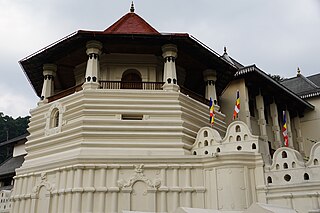
Paththirippuwa or Pattirippuwa is an octagonal pavilion and one of three main structures which comprise the Temple of the Tooth.
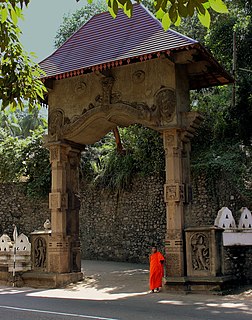
Malwathu Maha Viharaya is a Buddhist monastery located in Kandy, Sri Lanka. It is the headquarters of the Malwatta chapter of Siyam Nikaya and one of the two Buddhist monasteries that holds the custodianship of sacred tooth relic of Lord Buddha kept in Sri Dalada Maligawa, Kandy. The chief incumbent of the Malwathu Maha Viharaya is the Mahanayaka thero of Malwatta chapter of Siyam nikaya, a leading Buddhist monastic fraternity in Sri Lanka. The present chief incumbent of Malwathu Maha Viharaya is venrable Thibbatuwawe Sri Siddhartha Sumangala Thero.
Asgiri Maha Viharaya is a Buddhist monastery located in Kandy, Sri Lanka. It is the headquarters of the Asgiriya chapter of Siyam Nikaya, one of the two Buddhist monasteries that holds the custodianship of sacred tooth relic of Lord Buddha kept in Sri Dalada Maligawa, Kandy. The chief incumbent of the Asgiri Maha Viharaya is the Mahanayaka thero of Asgiri chapter of Siyam nikaya, a leading Buddhist monastic fraternity in Sri Lanka. The present chief incumbent of Asgiri Maha Viharaya is venrable Warakagoda Sri Gnanarathana Thero. Asgiri Maha Vihara traces its origin from the wanavasi sect of the Dimbulagala forest monastery of Polonnaruva. Currently 565 Buddhist temples in Sri Lanka functions under Asgiri Viharaya of Kandy.

The History of the Kandyan Kingdom in Sri Lanka starts with its foundation in 1476.
